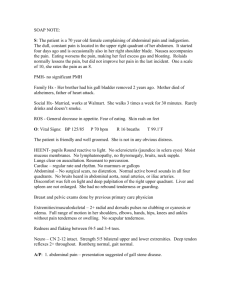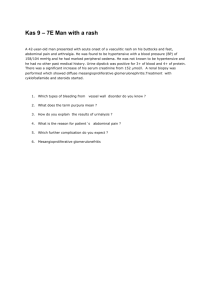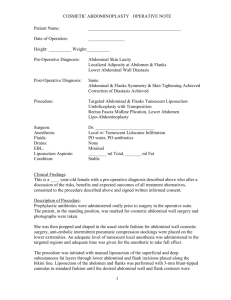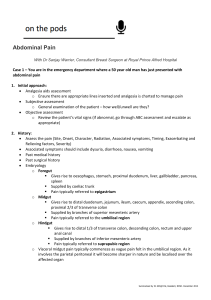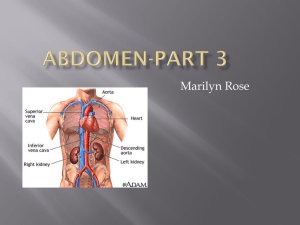Abdominal wall and retroperitoneum
advertisement
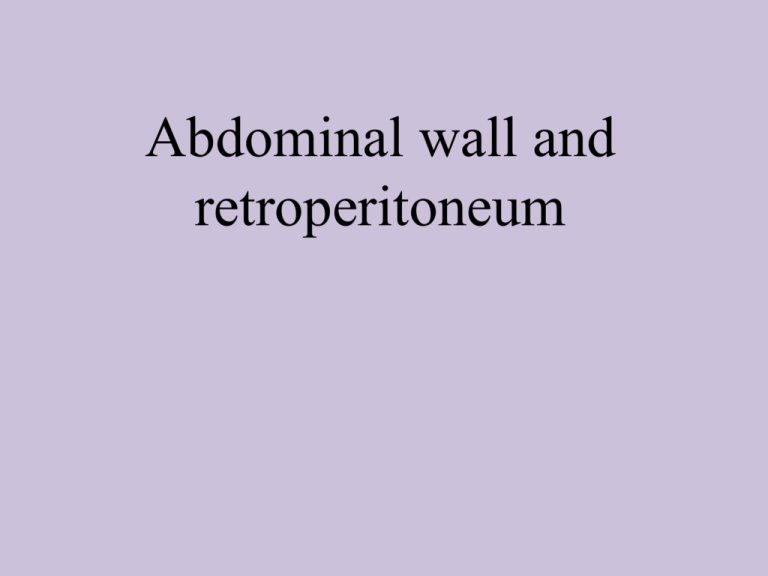
Abdominal wall and retroperitoneum ABDOMINAL WALL The abdominal wall provides structure,protection, and support for abdominal and retroperitoneal structures and is defined superiorly by the costal margins, inferiorly by the pelvic ring,and posteriorly by the vertebral column. The abdominal wall is an anatomically complex, layered structure with segmentally derived blood supply and innervation. It is mesodermal in origin and develops as bilateral migrating sheets, which originate in the paravertebral region and envelop the future abdominal area. The leading edges of these structures develop into the rectus abdominis muscles, which eventually meet in the anterior midline. The rectus abdominis is longitudinally oriented and encased within an aponeurotic sheath, the layers of which are fused in the midline at the linea alba. The rectus insertions are on the pubic bones inferiorly and on the fifth and sixth ribs, as well as the seventh costal cartilages and the xiphoid process . superiorly. The lateral border of the rectus muscles has a curved shape identifiable as the surface landmark, the linea semilunaris. Three tendinous intersections cross the rectus muscles at the level of the xiphoid process, umbilicus, and about halfway between the xiphoid process and the umbilicus. Lateral to the rectus sheath are three muscular layers with oblique fiber orientations relative to one another . These layers are derived from laterally migrating mesodermal tissues during the sixth to seventh week of fetal development. The external oblique muscle runs inferiorly and medially, arising from the margins of the lowest eight ribs and costal cartilages. The external oblique muscles originate on the latissimus dorsi and serratus anterior muscles, as well as on the iliac crest. Medially, the external obliques form a tendinous aponeurosis, which is contiguous with the anterior rectus sheath. The inguinal ligament is the inferior-most edge of the external oblique aponeurosis, reflected posteriorly in the area between the anterior superior iliac spine and pubic tubercle. The internal oblique muscle lies deep to the external oblique and arises from the lateral aspect of the inguinal ligament, the iliac crest, and the thoracolumbar fascia. Its fibers course superiorly and medially and form a tendinous aponeurosis that contributes components to both the anterior and posterior rectus sheath. The lower medial and inferior-most fibers of the internal oblique may fuse with the lower fibers of the transversus abdominis muscle (the conjoined area). The inferior-most fibers of the internal oblique muscle are contiguous with the cremasteric muscle in the inguinal canal. These relationships are of critical significance in the management of inguinal hernias. The transversus abdominis muscle is the deepest of the three lateral muscles and runs transversely from the lowest six ribs, the lumbosacral fascia, and the iliac crest, to the lateral border of the rectus abdominis. The arcuate line (semicircular line of Douglas) lies roughly at the level of the anterior superior iliac spines. The blood supply to the muscles of the anterior abdominal wall is derived mainly from the superior and inferior epigastric arteries.The superior epigastric artery arises from the internal thoracic artery, while the inferior epigastric artery arises from the external iliac artery. A collateral network of branches of the subcostal and lumbar arteries also contributes the abdominal wall blood supply. The lymphatic drainage of the abdominal wall is predominantly to the major nodal basins in the superficial inguinal and axillary areas. Abdominal Anatomy and Surgical Incisions incisions for open peritoneal access can be longitudinal (in or off the midline), transverse(lateral to or crossing midline), or oblique (directed either upward or downward toward the flank) procedures on the gastrointestinal tract. Incising the fused midline aponeurotic tissue of the linea alba is simple and does not injure skeletal muscle. Paramedian incisions through the rectus abdominis sheath structures have largely been abandoned in favor of midline or nonlongitudinal incisions. Incisions lateral to the midline made with transverse or oblique orientations can either divide the successive muscular layers or bluntly separate the fibers. This latter muscle-splitting approach, exemplified by the classic McBurney incision for appendectomy, may be less destructive to tissue but offers more limited exposure. Subcostal incisions on the right (Kocher incision for cholecystectomy) or left (for splenectomy) are archetypal muscle-dividing incisions that result in transection of intervening musculoaponeurotic tissues, including a portion of the rectus abdominis. Congenital abnormalities The abdominal wall layers begin to form within in first weeks following conception. In early embryonic development, there is a large central defect through which pass the vitelline (omphalomesenteric) duct and allantois. The vitelline duct connects the embryonic and fetal midgut to the yolk sac. During the sixth week of development, the abdominal contents grow too large for the abdominal wall to completely contain them, and the embryonic midgut herniates into the umbilical cord. While outside the developing abdomen, it undergoes a 270-degree counterclockwise rotation on the developing mesentery. At the end of the twelfth week, it returns to the abdominal cavity. Defects in abdominal wall closure may lead to omphalocele or gastroschisis.In omphalocele, viscera protrude through an open umbilical ring and are covered by a sac derived from the amnion. In gastroschisis, the viscera protrude through a defect lateral to the umbilicus and no sac is present. During the third trimester, the vitelline duct regresses. Persistence of a vitelline duct remnant on the ileal border results in a Meckel’s diverticulum . Complete failure of the vitelline duct to regress results in a vitelline duct fistula, which is associated with drainage of small intestinal contents from the umbilicus.If both the intestinal and umbilical ends of the vitelline duct regress into fibrous cords, a central vitelline duct (omphalomesenteric) cyst may occur. Persistent vitelline duct remnants between the gastrointestinal tract and the anterior abdominal wall may be associated with small intestinal volvulus in neonates.When diagnosed, vitelline duct fistulas and cysts should be excised along with any accompanying fibrous cord.The urachus is a fibromuscular tubular extension of the allantois that develops with the descent of the bladder to its pelvic position.persistance of urachal remnants result drainage of urine from the umbilicus.these are treated by urachal excision and closure of bladder defect Rectus Abdominis Diastasis. Rectus abdominis diastasis (or diastasis recti) results from a separation of the two rectus abdominis muscle pillars. This results in the characteristic bulging of the abdominal wall in the epigastrium that is sometimesmistaken for a ventral hernia despite the fact that the midline aponeurosis is intact and no hernia defect is present. Diastasis may be congenital, as a result of a more lateral insertion of the rectus muscles to the ribs and costochondral junctions, but is more typically an acquired condition with advancing age, obesity,or following pregnancy. In the postpartum setting, rectus diastasis tends to occur in women of advanced maternal age,after multiple or twin pregnancies, or in women who deliver high-birth-weight infants. Diastasis is usually easily identified on physical examination Computed tomography (CT) scanning can provide an accurate measure of the distance between the rectus pillars and will differentiate rectus diastasis from a true ventral hernia if clarification is required. Surgical correction of rectus diastasis by plication of the broad midline aponeurosis has been described for cosmetic indications and for disability of abdominal wall muscular function. However, these approaches introduce the risk of an actual ventral hernia and are of questionable value in addressing any actual pathology Rectus Sheath Hematoma Hemorrhage from the network of collateralizing vessels within the rectus sheath and muscles can result in a rectus sheath hematoma. Although a history of trauma might be elicited, other less obvious events including sudden contraction of the rectus muscles with coughing, sneezing, or any vigorous physical activity may also cause this condition. Spontaneous rectus sheath hematomas occur most frequently in the elderly and in those on anticoagulation therapy. Patients frequently describe the sudden onset of unilateral abdominal pain that may be confused with lateralized peritoneal disorders such as appendicitis. History and physical examination alone may be diagnostic. Pain typically increases with contraction of the rectus muscles,and a tender mass may be palpated. The ability to appreciate an intra-abdominal mass is ordinarily degraded with contraction of the rectus muscles. Fothergill’s sign is a palpable abdominal mass that remains unchanged with contraction of the rectus muscles and is classically associated with rectus hematoma. A hemoglobin/hematocrit level and coagulation studies should be obtained. Both ultrasonography and CT.can provide confirmatory imaging information and exclude other disorders. Specific treatment depends on the severity of the hemorrhage.Small, unilateral, and stable hematomas may be observed without hospitalization. Bilateral or large hematomas will likely require hospitalization, as well as potential resuscitation. Transfusion or coagulation factor replacement may be indicated insome situations. Angiographic embolization is required infrequently,but may be necessary if hematoma enlargement, free bleeding, or clinical deterioration occurs. Surgical therapy is used in the rare situations of failed angiographic treatment or hemodynamic instability that precludes any other options. The operative goals are evacuation of the hematoma and ligation of any bleeding vessel identified. Desmoid Tumors Desmoid tumors of the abdominal wall are fibrous neoplasms originating from the musculoaponeurotic structures of the anterior abdomen. They are also referred to collectively as aggressive fibrosis, a term that describes their aggressive and infiltrative local behavior. They do not have metastatic potential, and although there is marked cellularity in biopsy specimens, there are no specific histologic characteristicsthat suggest malignancy, per se. Desmoid tumors of the abdominal wall have a slight female predominance and occur either sporadically or in the setting of familial adenomatous polyposis (FAP), with the greatest risk incurred in Gardner’s syndrome. In non-FAP settings, abdominal wall desmoids occur most frequently in postpartum women or in surgical scars. Radical resection with frozen section margins and immediate mesh reconstruction of any consequent abdominal wall defect is the most commonly recommended treatment. Involvement of margins is associated with recurrence rates as high as 80%. Extensive infiltration and involvement of peritoneal structures frequently makes desmoid resection technically unfeasible. Medical treatment with an antineoplastic agent such as doxorubicin, dacarbazine, or carboplatin can produce remission for variable periods in up to 50% of patients, although the prognosis of advanced desmoids, particularly in FAP, is poor, with a 5-year mortality rate as high as 50% reported. Abdominal Wall Hernias Hernias of the anterior abdominal wall, or ventral hernias, represent defects in the parietal abdominal wall fascia and muscle through which intra-abdominal or preperitoneal contents can protrude. Ventral hernias may be congenital or acquired. Acquired hernias may develop via slow architectural deterioration of the musculoaponeurotic tissues, or they may develop from failed healing of an anterior abdominal wall incision (incisional hernia). The most common finding is a mass or bulge, which may increase in size with Valsalva. Ventral hernias may be asymptomatic or cause a considerable degree of discomfort and will generally enlarge over time. Physical examination reveals a bulge on the anterior abdominal wall that may reduce spontaneously, with recumbency, or with manual pressure. A hernia that cannot be reduced is described as incarcerated and generally requires surgical correction. Incarceration of an intestinal segment may be accompanied by nausea, vomiting, and significant pain, and is a true surgical emergency. If the blood supply to the incarcerated bowel is compromised, the hernia is described as strangulated, and the localized ischemia may lead to infarction and perforation. Primary ventral hernias (nonincisional) are generally named according to their anatomic location. Epigastric hernias are located in the midline between the xiphoid process and the umbilicus. They are generally small and may be multiple, and at elective repair, they are usually found to contain omentum or a portion of the falciform ligament. Umbilical hernias occur at the umbilical ring and may be present at birth or develop later in life. Umbilical hernias are present in approximately 10% of all newborns and are more common in premature infants. Most congenital umbilical hernias close spontaneously by 5 years. If closure does not occur, elective surgical repair is usually advised. Adults with small, asymptomatic umbilical hernias should be followed clinically. Surgical treatment is offered if a hernia is observed to enlarge or is associated with symptoms, or if incarceration occurs. Surgical treatment can consist of primary sutured repair or placement of prosthetic mesh for larger defects (>2 cm) using open or laparoscopic methods. Patients with advanced liver disease, ascites, and umbilical hernia require special consideration. Enlargement of the umbilical ring usually occurs in this clinical situation as a result of increased intra-abdominal pressure from uncontrolled ascites. First line of therapy is aggressive medical correction of the ascites and paracentesis for tense ascites with respiratory compromise. These hernias are usually filled with ascitic fluid, but omentum or bowel may enter the defect after large-volume paracentesis. Uncontrolled ascites may lead to skin breakdown on the protuberant hernia and eventual ascitic leak, which can predispose the patient to bacterial peritonitis. Patients with refractory ascites may be candidates for transjugular intrahepatic portocaval shunt (TIPS) or eventual liver transplantation.Umbilical hernia repair should be deferred until after the ascites is controlled. OMENTUM The greater omentum and lesser omentum are fibrofatty aprons that provide support, coverage, and protection of peritoneal contents.These structures begin to develop during the fourth week of gestation. The greater omentum develops from the dorsal mesogastrium,which begins as a double-layered structure. The spleen develops in between the two layers, and later in development, the two layers fuse, giving rise to the intraperitoneal spleen and the gastrosplenic ligament. The fused layers then hang from the greater curvature of the stomach and drape over the transverse colon, to which its posterior surface becomes fixed The gastrocolic ligament and the gastrosplenic ligament are those segments of the greater omental apron that connect the named structures. In the adult, the greater omentum lies in between the anterior abdominal wall and the hollow viscera and usually extends into the pelvis. The lesser omentum, otherwise known as the hepatoduodenal and hepatogastric ligaments, develops from the mesoderm of the septum transversum, which connects the embryonic liver to the foregut. The common bile duct, portal vein, and hepatic artery are located in the inferolateral margin of the lesser omentum, which also forms the anterior border of the foramen of Winslow. Omental Cysts Omental cysts are far less common than mesenteric cysts. Omental cysts may present as an asymptomatic abdominal mass or may cause abdominal pain with or without appreciable mass or distention. Physical examination may reveal a freely mobile intraabdominal mass. Both CT and abdominal ultrasound reveal a well-circumscribed, cystic-mass lesion arising from the greater omentum. Treatment involves resection of all symptomatic omental cysts. Resection of these benign lesions is readily accomplished using laparoscopic techniques. Omental Neoplasms Primary tumors of the omentum are rare. Benign tumors of the omentum include lipomas, myxomas, and desmoid tumors. Primary malignant tumors of the omentum are usually mesodermally derived and may share immunohistochemical characteristics of gastrointestinal stromal tumors including ckit immunopositivity. Metastatic tumors of the omentum are common, with metastatic ovarian cancer having the highest preponderance of omental involvement. Cancers of any portion of the gastrointestinal tract, as well as melanoma, uterus, and kidney cancer, may also metastasize to the omentum. MESENTERY The small and large intestinal mesenteries serve as the major pathways for arterial, venous, lymphatic, and neural structures to course to and from the bowel. Mesenteric tissues develop from embryonic dorsal mesentery that attaches the foregut, midgut, and hindgut to the posterior abdominal wall. The dorsal mesentery becomes the greater omentum proximally, the small intestinal mesentery in the region of the jejunum and ileum, and the mesocolon in the region of the colon. Sclerosing Mesenteritis Sclerosing mesenteritis, also referred to as retractile mesenteritis, mesenteric panniculitis, or mesenteric lipodystrophy, is an inflammatory and fibrotic process involving the intestinal mesentery. There is no gender or race predominance, but the condition is most commonly diagnosed in individuals older than 50 years of age. The etiology of this process is unknown, but its cardinal feature is increased tissue density within the mesentery. This can be localized and associated with a discrete nonneoplastic mesenteric mass, or it can be more diffuse, sometimes involving large swaths of mesentery without well-defined borders. There may be varying relative degrees of fat tissue degeneration, inflammation, and fibrosis on histologic examination, giving a mass or, much more rarely, intestinal obstruction. However, many cases are discovered incidentally when imaging studies, most frequently CT scan, are performed for unrelated reasons. CT of the abdomen shows a mass lesion or an area of the mesentery with a higher density than normal mesenteric tissue. Vascular structures are seen coursing through the affected areas, which sometimes involve in the mesenteric root. Although CT cannot definitively distinguish sclerosing mesenteritis from a mesenteric tumor, identification of a “fat ring sign” or hypodense zone around the mass area has been suggested as a means of distinguishing sclerosing mesenteritis from lymphoma. The presence of a hyperattenuating stripe has also been suggested as radiologic finding that would favor the mesenteritis diagnosis. Operative findings range from a discrete mesenteric mass to broad areas of mesenteric nodularity and thickening. Surgical biopsy has frequently been used to confirm the diagnosis and to rule out a neoplastic process. In most cases of sclerosing mesenteritis, the process appears to be self-limited and may even demonstrate regression if followed with interval imaging studies. Clinical symptoms are very likely to improve without intervention, and therefore,aggressive surgical treatments are generally not indicated. In clinically problematic cases that are not amenable to resection because of widespread mesenteric involvement or unfavorable location, medical treatment has been given to alleviate severe symptoms. Among the agents that have been used are corticosteroids, colchicine, tamoxifen, and cyclophosphamide. Mesenteric Cysts Mesenteric cysts may be asymptomatic or cause acute or chronic symptoms of a mass lesion. Acute pain is generally caused by rupture or torsion of the cyst or from acute hemorrhage into the cyst cavity. Mesenteric cysts may also cause intermittent abdominal pain secondary to compression of adjacent structures or reversible torsion of the cyst. Mesenteric cysts can also be the cause of nonspecific symptoms such as anorexia, nausea, vomiting, fatigue, and weight loss. Physical examination may reveal a mass lesion that is mobile only from the patient’s right to left or left to right (Tillaux’s sign), in contrast to the findings with omental cysts, which should be freely mobile in all directions. CT ,ultrasound, and MRI all have been used to evaluate patients with mesenteric cysts. When symptomatic, simple mesenteric cysts are surgically excised either openly or laparoscopically. Mesenteric Tumors Primary tumors of the mesentery are rare. Benign tumors of the mesentery include lipoma, cystic lymphangioma, and desmoid tumors. Primary malignant tumors of the mesentery are similar to those described for omentum. Liposarcomas,leiomyosarcomas, malignant fibrous histiocytomas, lipoblastomas, and lymphangiosarcomas have all been described. Metastatic small intestinal carcinoid in mesenteric lymph nodes may exceed the bulk of primary disease and compromise blood supply to the bowel. Treatment of mesenteric malignancies involves wide resection of the mass. Because of the proximity to the blood supply to the intestine, such resections may be technically unfeasible or involve loss of substantial lengths of bowel RETROPERITONEUM The retroperitoneum is defined as the space between the posterior envelopment of the peritoneum and the posterior body wall.The retroperitoneal space is bounded superiorly by the diaphragm, posteriorly by the spinal column and iliopsoas muscles, and inferiorly by the levator ani muscles. Although technically bounded anteriorly by the posterior reflection of the peritoneum, the anterior border of the retroperitoneum is quite convoluted, extending into the spaces in between the mesenteries of the small and large intestine. Because of the rigidity of the superior, posterior, and inferior boundaries, and the compliance of the anterior margin, retroperitoneal tumors tend to expand anteriorly toward the peritoneal cavity. Retroperitoneal Infections The posterior reflection of the peritoneum limits the spread of most intra-abdominal infections into the peritoneum.Accordingly, the source of retroperitoneal infections is usually an organ contained within or abutting the retroperitoneum. Retrocecal appendicitis, contained perforation of duodenal ulcers, iatrogenic perforation with esophagogastroduodenoscopy or endoscopic retrograde cholangiopancreatography, and complicated pancreatitis may all lead to retroperitoneal infection with or without abscess formation. The substantial space and rather nondiscrete boundaries of the retroperitoneum allow some retroperitoneal abscesses to become quite large prior to diagnosis. Patients with a retroperitoneal abscess usually present with pain and fever, but more worrisome signs of sepsis may also be present depending on clinical severity. The site of pain may be variable and can include the back, pelvis, or thighs. Erythema may be observed around the umbilicus or flank. The diagnosis is best established by CT, which may demonstrate a unilocular or multilocular collection along with retroperitoneal soft tissueStranding. Management of retroperitoneal infections includes identification and treatment of the underlying condition, intravenous antibiotics, and drainage of all well-defined collections. Imageguided percutaneous drainage is strongly favored, but operative drainage may sometimes be needed for adequate drainage of complex or multiple collections. The mortality rate of retroperitoneal abscess has been reported to be as high as 25%, and even higher in rare cases of necrotizing fasciitis of the retroperitoneum. Retroperitoneal Fibrosis Retroperitoneal fibrosis is a class of disorders characterized by hyperproliferation of fibrous tissue in the retroperitoneum. This may be a primary disorder as in idiopathic nretroperitoneal fibrosis, also known as Ormond’s disease, or a secondary reaction to an inciting inflammatory process, malignancy, or medication. Although allergic or autoimmune mechanisms have been postulated, the pathogenesis of this condition remains uncertain. The fibrotic process begins in the retroperitoneum just below the level of the renal arteries. Fibrosis gradually expands, encasing the ureters, inferior vena cava, aorta, mesenteric vessels, or sympathetic nerves. Bilateral involvement is noted in 67% of cases. There is strong evidence that methysergide, a semisynthetic ergot alkaloid used in the treatment of migraine headaches, plays a causal role in some cases of retroperitoneal fibrosis. Presenting symptoms depend on the structure or structures affected by the fibrotic process. Abdominopelvic CT with oral and intravenous contrast is the imaging procedure of choice and will generally allow the extent of the fibrotic process to be determined. Once malignancy, drug-induced, and infectious etiologies are ruled out, treatment of the retroperitoneal fibrotic process is instituted. Corticosteroids, with or without surgery, are the mainstay of medical therapy. Surgical treatment consists primarily of ureterolysis or ureteral stenting and is required in patients who present with significant hydronephrosis.


